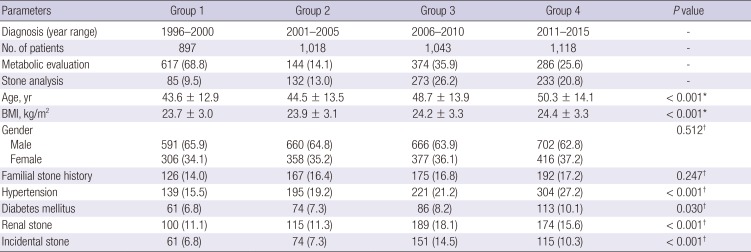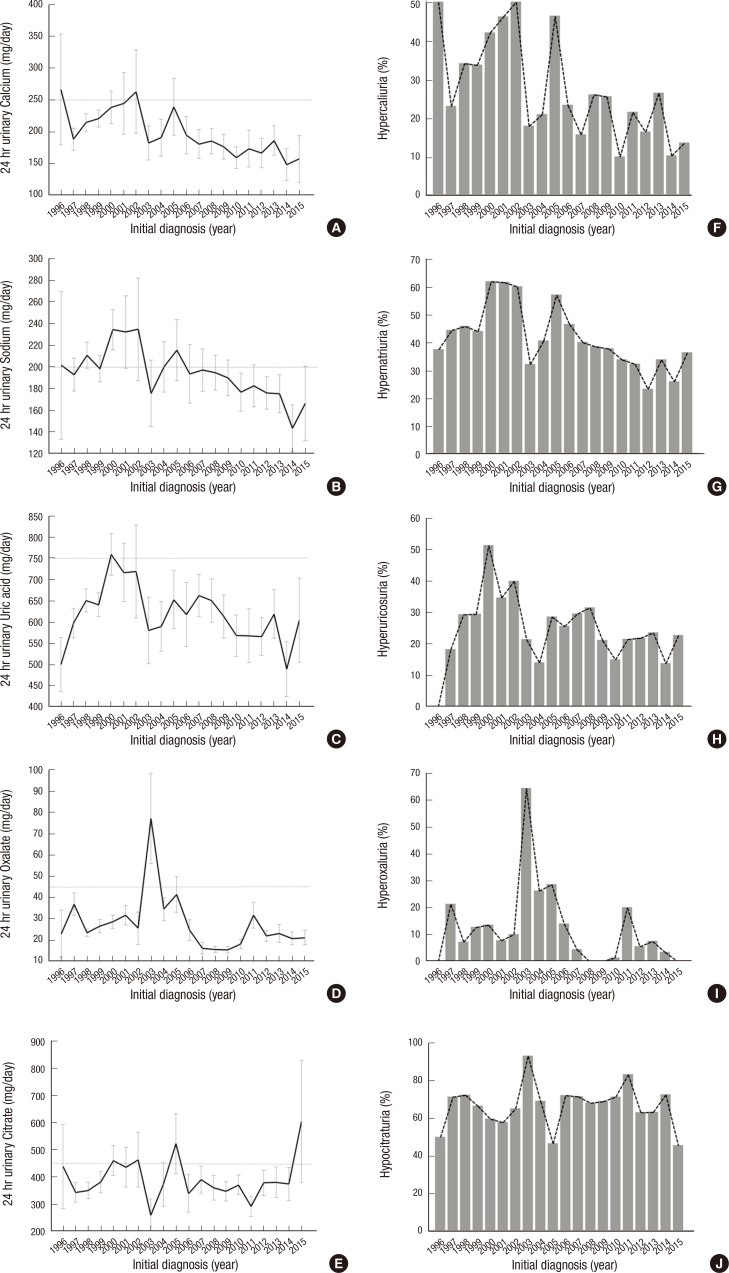1. Skolarikos A, Straub M, Knoll T, Sarica K, Seitz C, Petřík A, Türk C. Metabolic evaluation and recurrence prevention for urinary stone patients: EAU guidelines. Eur Urol. 2015; 67:750–763. PMID:
25454613.
2. Ramello A, Vitale C, Marangella M. Epidemiology of nephrolithiasis. J Nephrol. 2000; 13(Suppl 3):S45–S50. PMID:
11132032.
3. Bae SR, Seong JM, Kim LY, Paick SH, Kim HG, Lho YS, Park HK. The epidemiology of reno-ureteral stone disease in Koreans: a nationwide population-based study. Urolithiasis. 2014; 42:109–114. PMID:
24526235.
4. Yasui T, Iguchi M, Suzuki S, Kohri K. Prevalence and epidemiological characteristics of urolithiasis in Japan: national trends between 1965 and 2005. Urology. 2008; 71:209–213. PMID:
18308085.
5. Huang WY, Chen YF, Carter S, Chang HC, Lan CF, Huang KH. Epidemiology of upper urinary tract stone disease in a Taiwanese population: a nationwide, population based study. J Urol. 2013; 189:2158–2163. PMID:
23313204.
6. Lim S, Shin H, Song JH, Kwak SH, Kang SM, Won Yoon J, Choi SH, Cho SI, Park KS, Lee HK, et al. Increasing prevalence of metabolic syndrome in Korea: the Korean national health and nutrition examination survey for 1998–2007. Diabetes Care. 2011; 34:1323–1328. PMID:
21505206.
7. Park HS, Oh SW, Cho SI, Choi WH, Kim YS. The metabolic syndrome and associated lifestyle factors among South Korean adults. Int J Epidemiol. 2004; 33:328–336. PMID:
15082635.
8. Park J, Suh B, Lee MS, Woo SH, Shin DW. National practice pattern and time trends in treatment of upper urinary tract calculi in Korea: a nationwide population-based study. J Korean Med Sci. 2016; 31:1989–1995. PMID:
27822940.
9. Lee SC, Kim YJ, Kim TH, Yun SJ, Lee NK, Kim WJ. Impact of obesity in patients with urolithiasis and its prognostic usefulness in stone recurrence. J Urol. 2008; 179:570–574. PMID:
18078957.
10. Kohjimoto Y, Sasaki Y, Iguchi M, Matsumura N, Inagaki T, Hara I. Association of metabolic syndrome traits and severity of kidney stones: results from a nationwide survey on urolithiasis in Japan. Am J Kidney Dis. 2013; 61:923–929. PMID:
23433467.
11. Torricelli FC, De SK, Gebreselassie S, Li I, Sarkissian C, Monga M. Dyslipidemia and kidney stone risk. J Urol. 2014; 191:667–672. PMID:
24055417.
12. Kim YJ, Ha YS, Jo SW, Yun SJ, Chu IS, Kim WJ, Lee SC. Changes in urinary lithogenic features over time in patients with urolithiasis. Urology. 2009; 74:51–55. PMID:
19428063.
13. Lifshitz DA, Shalhav AL, Lingeman JE, Evan AP. Metabolic evaluation of stone disease patients: a practical approach. J Endourol. 1999; 13:669–678. PMID:
10608520.
14. Norman RW. Metabolic evaluation of stone disease patients: a practical approach. Curr Opin Urol. 2001; 11:347–351. PMID:
11429492.
15. Trinchieri A. Epidemiology of urolithiasis. Arch Ital Urol Androl. 1996; 68:203–249. PMID:
8936716.
16. Lee S, Kim MS, Kim JH, Kwon JK, Chi BH, Kim JW, Chang IH. Daily mean temperature affects urolithiasis presentation in Seoul: a time-series analysis. J Korean Med Sci. 2016; 31:750–756. PMID:
27134497.
17. Kang DH, Cho KS, Ham WS, Chung DY, Kwon JK, Choi YD, Lee JY. Ureteral stenting can be a negative predictor for successful outcome following shock wave lithotripsy in patients with ureteral stones. Investig Clin Urol. 2016; 57:408–416.
18. Safarinejad MR. Adult urolithiasis in a population-based study in Iran: prevalence, incidence, and associated risk factors. Urol Res. 2007; 35:73–82. PMID:
17361397.
19. Kim SC, Moon YT, Hong YP, Hwang TK, Choi SH, Kim KJ, Sul CK, Park TC, Kim YG, Park KS. Prevalence and risk factors of urinary stones in Koreans. J Korean Med Sci. 1998; 13:138–146. PMID:
9610613.
20. Kwon S. Thirty years of national health insurance in South Korea: lessons for achieving universal health care coverage. Health Policy Plan. 2009; 24:63–71. PMID:
19004861.
21. Park HS, Park CY, Oh SW, Yoo HJ. Prevalence of obesity and metabolic syndrome in Korean adults. Obes Rev. 2008; 9:104–107.
22. Calvert RC, Burgess NA. Urolithiasis and obesity: metabolic and technical considerations. Curr Opin Urol. 2005; 15:113–117. PMID:
15725935.
23. Kim SS, Luan X, Canning DA, Landis JR, Keren R. Association between body mass index and urolithiasis in children. J Urol. 2011; 186:1734–1739. PMID:
21855900.
24. Asplin JR. Obesity and urolithiasis. Adv Chronic Kidney Dis. 2009; 16:11–20. PMID:
19095201.
25. Lee MJ, Popkin BM, Kim S. The unique aspects of the nutrition transition in South Korea: the retention of healthful elements in their traditional diet. Public Health Nutr. 2002; 5:197–203. PMID:
12027285.
26. Heath GW, Parra DC, Sarmiento OL, Andersen LB, Owen N, Goenka S, Montes F, Brownson RC; Lancet Physical Activity Series Working Group. Evidence-based intervention in physical activity: lessons from around the world. Lancet. 2012; 380:272–281. PMID:
22818939.
27. Song Y, Joung H. A traditional Korean dietary pattern and metabolic syndrome abnormalities. Nutr Metab Cardiovasc Dis. 2012; 22:456–462. PMID:
21215606.








 PDF
PDF ePub
ePub Citation
Citation Print
Print




 XML Download
XML Download